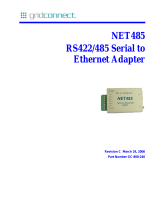
Hardware Description
www.digi.com 9
The RJ45 connector is integrated with the isolation transformer, EMI filter
components, link, and receive LEDs.
You also can use the MII interface to determine the current Ethernet link status.
Change of link status can cause an interrupt on IRQ0*.
The Intel 3V PHY Reset* signal can be connected to the NET+ARM PORTB4 GPIO
signal or hardware reset using option resistors. The PORTB4 (R80) signal can be
driven low to provide a hard reset to the PHY. Current population uses hardware
reset (R75).
The Intel PHY PHYINT* signal is connected to the NET+ARM PORTC0 IRQ0* signal. The
PORTC0 input can be configured to generate an interrupt on the high to low
transition of PHYINT*. Using this interrupt is not a requirement.
MIC (IEEE1284, GPIO, and ENI interfaces)
You can configure the development board to operate using either the IEEE1284
parallel ports, GPIO mode, or the ENI interface. You can use one interface at a time.
1284 parallel port ENI interface
External glue logic is required to use the IEEE1284 interface. See the IEEE1284
section in the Hardware Reference Guide. This is a multiplexed interface that uses
one 74FCT16646 per port. All inputs require 5V to 3.3V translation.
GPIO interface
There are 16 I/O pins and 16 input only pins. Inputs can be set to cause an interrupt
or can be polled. Most outputs have 2ma drive with the exception of PORTF7, which
has 8ma drive. Signals PBD15:8 should have no connections in GPIO mode.
ENI/DPO interface
If you use a cable to connect to connector P10, the cable should be three inches or
shorter. A data buffer may be required. This buffer can be controlled by ENI signals
PBRW*(DIR) and PEN*(OE*).





















